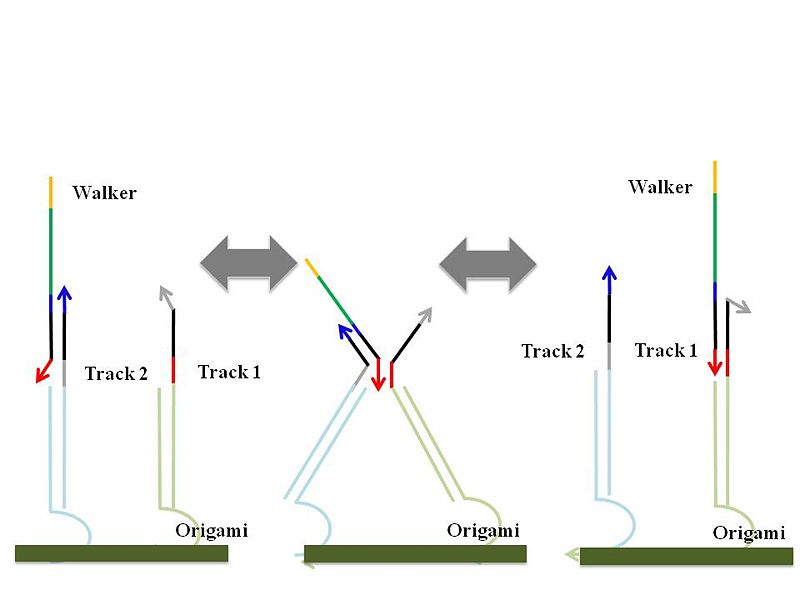Biomod/2011/Caltech/DeoxyriboNucleicAwesome/Domain Level Project Design: Difference between revisions
YAE LIM Lee (talk | contribs) No edit summary |
YAE LIM Lee (talk | contribs) No edit summary |
||
| Line 26: | Line 26: | ||
move randomly between track strands without modifying previously visited track segments. | move randomly between track strands without modifying previously visited track segments. | ||
[[Image: | [[Image: ssslide14.jpg | 800px | thumb|center]] | ||
[[Image: | [[Image: ssslide15.jpg | 800px| thumb|center]] | ||
| Line 34: | Line 34: | ||
===Cargo Pick-Up Mechanism=== | ===Cargo Pick-Up Mechanism=== | ||
[[Image: | [[Image: ssslide16.jpg | 800px| thumb|center]] | ||
===Cargo Drop-Off Mechanism=== | ===Cargo Drop-Off Mechanism=== | ||
[[Image: | [[Image: ssslide17.jpg | 800px| thumb|center|]] | ||
===Walking to the Walker Goal Mechanism (for verification of random walking) === | ===Walking to the Walker Goal Mechanism (for verification of random walking) === | ||
[[Image: | [[Image: ssslide19.jpg | 800px| thumb|center|]] | ||
=== Triggering Mechanism=== | === Triggering Mechanism=== | ||
| Line 51: | Line 49: | ||
====Walker Triggering==== | ====Walker Triggering==== | ||
[[Image: | [[Image: ssslide12.jpg | 800px| thumb|center|]] | ||
====Cargo Goal Triggering==== | ====Cargo Goal Triggering==== | ||
[[Image: | [[Image: ssslide13.jpg | 800px| thumb|center|]] | ||
Revision as of 07:50, 3 November 2011
|
Tuesday, April 16, 2024
|
Domain Level DesignOverall Domain Design
To accomplish a cargo-reorganizing-task, a walker is extended to have picking up arm which is complementary to cargos (domain x and l in figure 1). When walker randomly walks and encounters a cargo molecule, it picks up the cargo by strand displacement using toehold l. It continues random walking after picking up, and when a walker gets to the cargo goal, cargo is dropped off at the cargo goal using toehold u/u*, which both cargo and cargo goal share. Therefore, random walking process is purely stochastic, yet a deterministic end result can be achieved by specific recognition between the cargo molecules and their destinations. Another important stand is walker goal. Since walker goal contains both a1* and a2* which are complementary to the both of the toeholds of the walker, walker stays on the walker goal when it gets there. Walker goal will be used in verifying random walking on origami, and its use will be explained in later section. While the system is under construction, (e.g. track being planted), a walker or cargo goal should be deactivated to prevent undesired random walking or cargo sorting. Walker inhibitor and cargo goal inhibitor are thus designed. Later, walker trigger and cargo goal trigger will rip off the inhibitors by strand displacement using toehold wi and cgi. Detacher stands were designed to detach particular strands from samples with origami for the future gel experiments. Probes are the extended part of staples which are complementary to the bottom part of the strands which should be anchored on the origami surface. Different kinds of probes were designed for each strand. Origami will be annealed with certain staples extended with probes at predetermined positions, and some strands, such as tracks or cargo goals, will be planted on those specific positions using interaction between probe regions. Detailed mechanisms are depicted below. Random Walking MechanismThe backbone of our design is a random walker that moves across the surface of a rectangular origami. The mechanism by which said walker moves is simply strand displacement, whereby the walker contains a toehold on each end of the body, and the track strands on which it walks contains the complement of one of the two toeholds on the walker. This particular arrangement allows the walker to move randomly between track strands without modifying previously visited track segments.  
Cargo Pick-Up Mechanism Cargo Drop-Off Mechanism
Walking to the Walker Goal Mechanism (for verification of random walking) Triggering MechanismWalker Triggering Cargo Goal Triggering
See Also |
